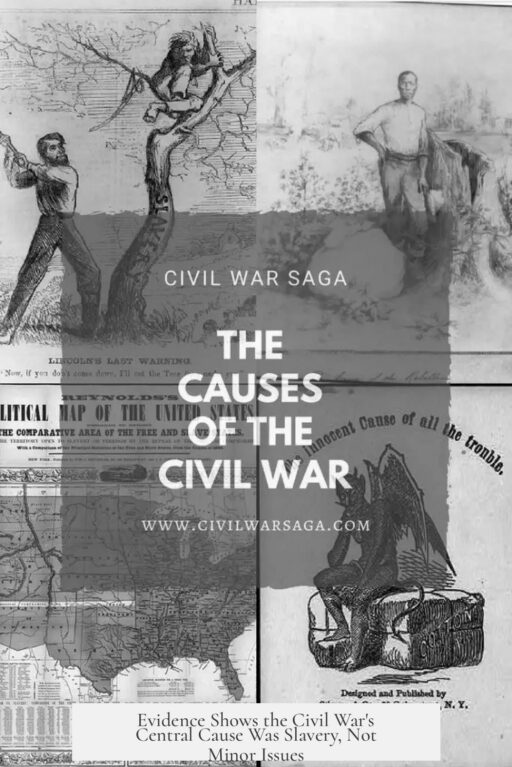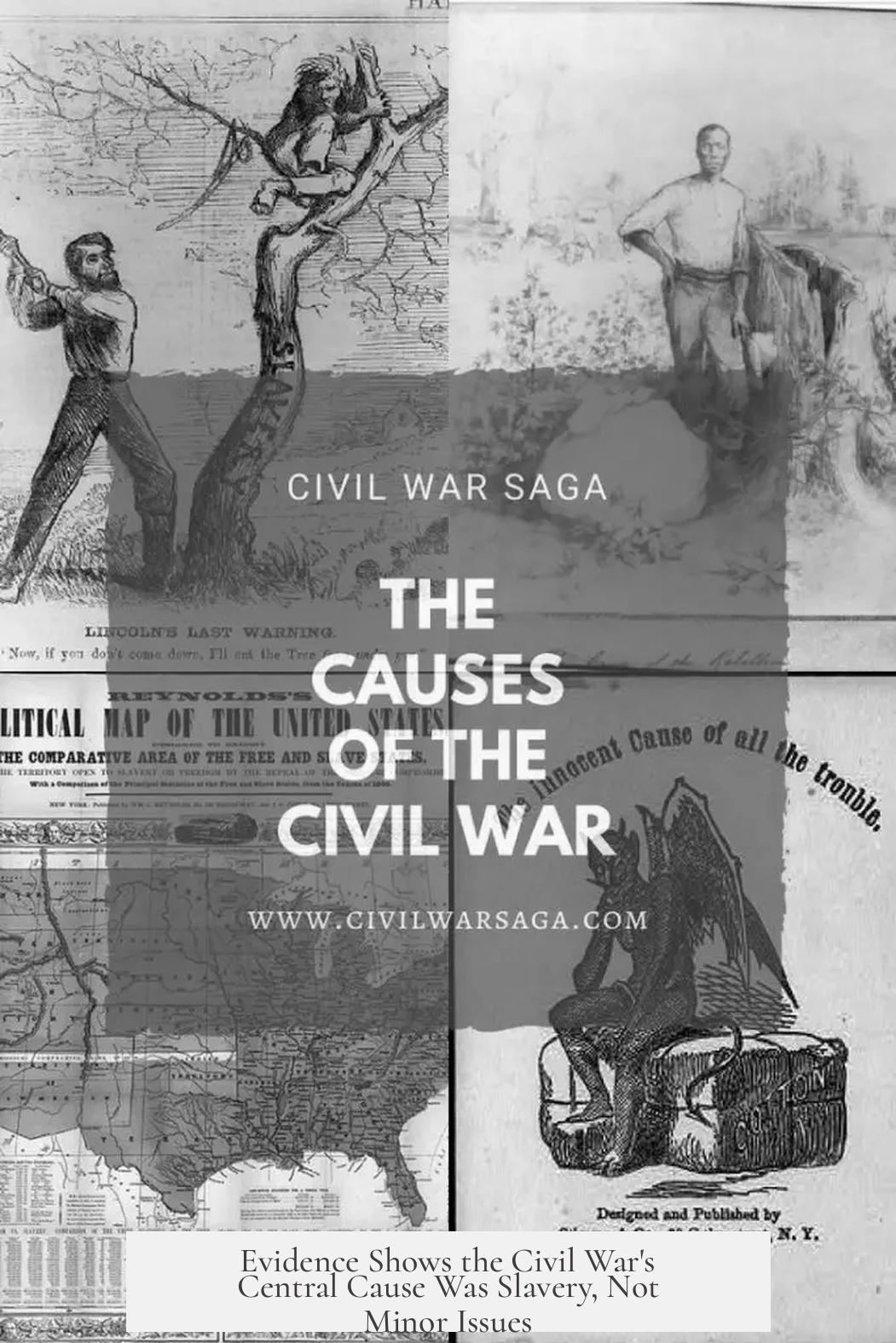The Civil War was overwhelmingly fought over slavery, as confirmed by extensive historical evidence including secession documents, political statements, and legal battles of the era. Arguments suggesting alternative causes such as states’ rights, tariffs, or class conflict fail to address the core issue: the preservation and expansion of slavery in the Southern states.
Slavery was the root cause of the Civil War despite the presence of other contemporaneous issues. While states’ rights are often cited as a cause, this concept functioned primarily as a tool to defend slavery rather than an independent rationale. States’ rights could be applied either to support or oppose slavery, as seen when some Northern states enacted personal liberty laws to counter the Fugitive Slave Act, asserting state sovereignty against slavery enforcement.
Southern political power was closely tied to protecting slavery. Southerners dominated all three branches of the federal government in the decades before the war, using this control to prevent anti-slavery legislation. The Senate maintained a fragile balance with an equal number of slave and free states, thereby blocking federal actions against slavery. Meanwhile, the 3/5ths Compromise inflated Southern representation, bolstering their political leverage.
Southern society depended on a rigid racial hierarchy. Wealthy planters dominated a social order that manipulated poor whites by promising them racial superiority and potential access to slave ownership. These elites promoted fear of a racial uprising if slavery were abolished, fostering loyalty to the institution and justifying secession.
Expansionist motives also centered on slavery. Southern elites sought to establish new slave states for economic gain and political power. The Republican Party platform aimed to halt slavery’s spread, threatening the South’s social and political dominance, which contributed to Southern leaders’ decision to secede.
A crucial distinction lies between a “slave society” in the South—one economically, politically, and culturally based on slavery—and the North, which was a “society with slaves,” where the institution was declining in importance. This fundamental difference underpinned the sectional tensions.
Claims that taxation or tariffs caused the war do not stand up to scrutiny. Issues like the Nullification Crisis revolved around power dynamics rather than tax rates, and border security concerns were minor and unrelated to slavery disputes. Even complaints about federal neglect, like those concerning Indian attacks on Texas, featured infrequently and were secondary compared to slavery.
Secession documents make the cause explicit. The Texas Declaration of Secession references slavery 21 times, emphasizing the state’s commitment to the institution. Other states’ declarations echo this sentiment, underscoring the centrality of preserving slavery rather than vague states’ rights.
Confederate leaders openly stated their intent to continue slavery as a cornerstone of their rebellion. These leaders were well-versed in constitutional law and deliberately framed secession around the defense of their economic interests, primarily enslaved labor, which constituted their largest financial assets.
The war began when Confederate forces fired on Fort Sumter, a federal installation, showing their commitment to rebellion. The federal government responded with authority to preserve the Union and uphold constitutional law.
Neo-Confederate and Lost Cause narratives, which attempt to reframe the war as about class or reluctant poor Southern whites, lack historical support. Poor whites had vested interests in preserving slavery and were active defenders of the racial order.
Before the war, legal battles over slavery intensified. Northern states passed laws opposing the Fugitive Slave Act, but Congress extended this act with harsher penalties, seeking to enforce slavery nationally. Compromises like Missouri and Kansas-Nebraska only delayed conflict, as sectional disputes over the expansion of slavery flared.
| Key Evidence | Details |
| Secession Declarations | Explicitly cite slavery as primary reason |
| Political Dominance | Southern control of government blocked anti-slavery laws |
| Society | Southern economy and culture depended on slavery |
| Legal Conflicts | Fugitive Slave Acts vs. Northern resistance laws |
| Military Actions | Confederate attack on Fort Sumter started war; rebellion against Union |
- Slavery was the foundational cause, not a secondary or minor one.
- States’ rights served as a justification for protecting slavery.
- Secession documents and leaders explicitly centered slavery as cause.
- Economic, social, and political Southern structures relied on slavery.
- Other issues, like tariffs and border security, were secondary or unrelated.
- Attempts to downplay slavery’s role conflict with extensive historical records.
Is There Actually Any Evidence the Civil War Wasn’t Fought Over Slavery?
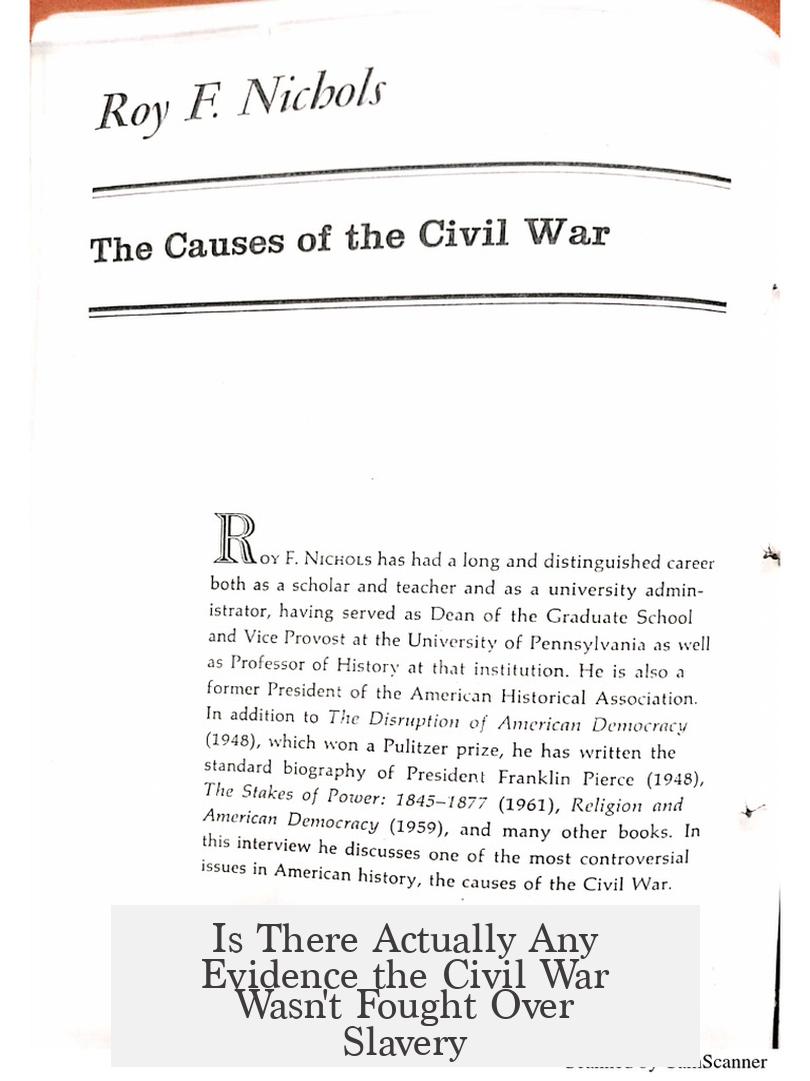
So, was the American Civil War really about anything other than slavery? The answer — based on a mountain of historical evidence — is a definitive no. Slavery sits at the very heart of the conflict. Other issues like states’ rights or tariffs pop up, but they’re distractions or excuses, not the true cause.
Let’s dig into why slavery was the driving force behind the Civil War, and why alternative explanations don’t hold up under serious scrutiny. This is a story of power, economy, society, and secession documents that leave little room for doubt.
Slavery: The Root Cause, Not Just a Side Topic
Many like to toss around “states’ rights” as the main reason the South went to war. But what does that phrase actually mean? It’s a VERY broad concept. States’ rights could be used to argue for or against slavery. In fact, states’ rights was merely the tool states used to justify secession—the real issue was the protection and continuation of slavery.
Zoom out and you quickly see slavery as the base of all other disputes. For example, Southern states insisted on keeping the right to own slaves and extend that institution into new territories. Their claim to “rights” held little meaning unconnected to the preservation of slavery.
Southern Political Power Protected Slavery at All Costs
| Branch of Government | Southern Influence | Effect on Slavery |
|---|---|---|
| Legislative (Senate) | Balanced 50/50 between free and slave states | Prevented anti-slavery laws from passing |
| Legislative (House) | North outvoted South, but divisions diluted anti-slavery efforts | Southern 3/5ths compromise boosted slave states’ representation |
| Judicial (Supreme Court) | Dominated by Southern slaveholders or sympathizers | Protected slavery as property under law |
The entire political landscape was skewed toward preserving slavery. Southern elites understood that their economy and social order depended on maintaining slavery — and used federal power to protect it.
Southern Society: A Slave-Based Power Structure

The South was not a just a place with some slaves; it was a slave society. Meaning: it was built purposefully around the institution of racial chattel slavery. This contrasted sharply with the North, which was a “society with slaves” but economically and culturally organized differently.
Southern aristocrats, the wealthy planter class, dominated politics and society. They used a carrot and stick approach to control poor whites — promising them a stake in the racial system (the hope of someday owning slaves) and instilling fear of racial chaos if slavery ended.
Moreover, the desire to expand slavery westward fueled tensions. Southern elites wanted new slave states and territories for plantations. The Republicans’ platform to eventually choke slavery off was a direct threat that sparked secession.
Minor Issues Don’t Add Up
Some argue the war was about tariffs, taxes, or border security. Let’s be honest — those claims don’t pass the smell test.
- Tariffs: They arose before but always about limiting federal power, not the tax itself.
- Border issues and Indian threats: Were barely a concern; the federal army maintained borders for decades.
- Complaints about federal neglect: Mostly made as secondary excuses tied directly or indirectly to slavery.
When Texas’ Articles of Secession mention slavery 21 times, compared to more minor references to Indian attacks or “banditti,” it’s obvious what truly mattered.
The Secession Documents Make It Crystal Clear
Want proof in their own words? Look no further.
Texas emphasized that it held “to the institution known as negro slavery,” and that this institution forged “the strongest ties” with other slaveholding states.
Every single secession declaration centers slavery as the basis for leaving the Union. The argument of “states’ rights” boils down to preserving the right to own slaves and to expand that right to new territories.
Confederate leaders were unapologetic about this. This wasn’t a vague disagreement over governance. They openly stated that the war was to keep slavery intact.
Military Actions and Federal Authority
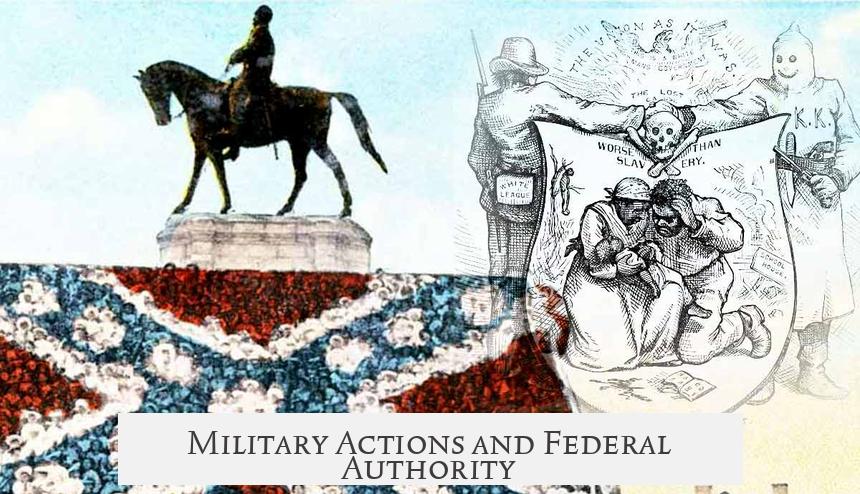
It wasn’t the North firing first. South Carolina’s forces opened fire on Fort Sumter, sparking war. President Lincoln viewed secession as illegal rebellion, grounded in a constitutional view that no state had the right to unilaterally sever the “perpetual Union.”
The federal government, therefore, justified its military response as enforcing the Union. The attack on federal property was an act of war.
Neo-Confederate Myths vs. Reality
Accounts pushing the “Lost Cause” narrative often claim poor Southern whites fought unwillingly or solely for class reasons. Reality check: poor whites were part of the racial order buttressed by slavery. Many owned slaves or hoped to, creating an investment in preserving this system.
Desertion rates and riots weren’t caused by class struggle, but often targeted abolitionists or those threatening slavery. Desertion happened on both sides, so it didn’t explain the Confederate defeat.
Pre-War Legal Battles Over Slavery Were Central
Long before the war, Northern states passed personal liberty laws to block the Fugitive Slave Acts that required them to help capture runaway slaves.
Meanwhile, the Southern-dominated Congress passed laws tightening fugitive laws, stripping accused runaways of rights, increasing tensions.
Legislation like the Missouri Compromise tried to maintain balance but was later shattered by acts like the Kansas-Nebraska Act and California’s free-state status. These power shifts fanned the flames leading to war.
What About Southern Intentions? Political Voices
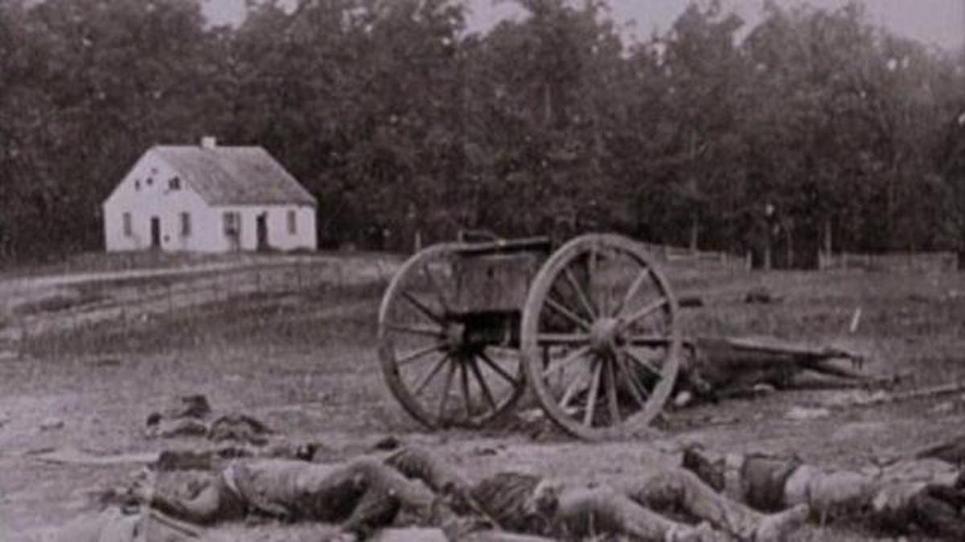
Benjamin Stringfellow, pro-slavery lawyer, said: “Those who are not with us [on human chattel slavery] are against us.”
This blunt statement mirrors the unified message of secessionists who considered any Northern interference on slavery unacceptable and a direct cause for parting ways.
Summary: Slavery Is the Unavoidable Truth
- Declarations of secession and political speeches place slavery at the core.
- Society, economy, and power structures in the South all revolved around slavery.
- Other reasons like tariffs, states’ rights, or border security play minor or supportive roles.
- The federal government’s efforts to limit slavery’s expansion incited secession.
- Neo-Confederate attempts to rewrite history ignore overwhelming evidence.
In short, all credible evidence confirms slavery was the essential and central cause of the Civil War. So if someone tells you otherwise, you can gently (or not-so-gently) remind them: look at the secession papers, listen to the Southern leaders themselves, and check the laws and policies that pushed the nation into conflict.
Slavery wasn’t just a minor ingredient – it was the very reason the Civil War boiled over, marking one of history’s most significant and tragic chapters.
Now, next time that question pops up, you’ll have the facts to carefully lay it out, with a dash of historical truth and a sprinkle of some well-deserved clarity.
